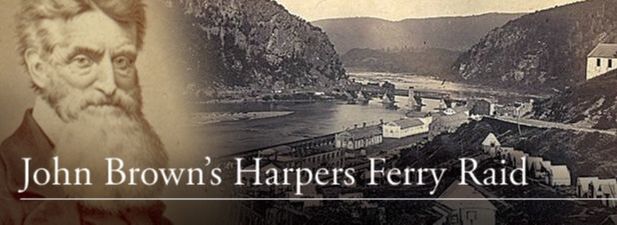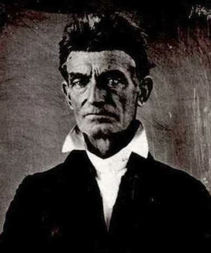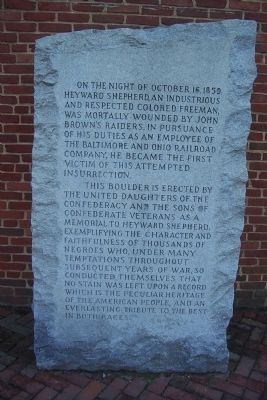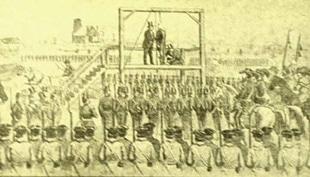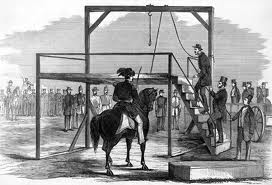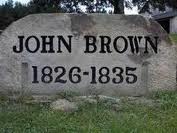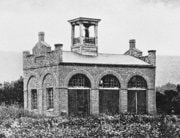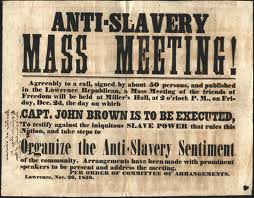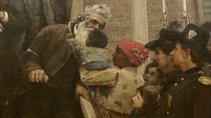Lesson Plan - Harper's Ferry Digital Field Trips with Janie Lynn Panagopoulos
Lesson Plan
Subject: John Brown at Harper’s Ferry, West Virginia, 1859
Objectives and Goals:
• Students will become familiar with the visual and historical location of Harper’s Ferry, West Virginia.
• Students will learn about John Brown’s 1859 raid on Harper’s Ferry.
Vocabulary:
• Slavery
• Abolitionist
• Freedom
• Armory
• Artillery
• Insurrection
• Arsenal
• Human Rights
• Slave Revolt
• Truce
• Surrender
Anticipatory Set (30 minute):
• Tell students briefly what this lesson is about.
• Ask students to define their understanding of the Civil War and its time frame.
• Ask students if they are familiar with the name John Brown.
• Ask students if they are familiar with the song “Old John Brown’s Body,” play a recording of the song, and share the words. https://youtu.be/lYjK-Oy4O-A?si=5FnaHvLullmsx3ID
Direct Instruction (90 minute):
Summary
On October 16, 1859, John Brown and 21 men attacked the small town of Harper’s Ferry, Virginia (before West Virginia was created). They attempted to seize the armory and other critical points of the town. By attacking the arsenal, John Brown’s “army of liberation” intended to arm escaped slaves to revolt against slaveholders throughout the South. Soon, local citizens understood Brown’s Abolitionist intentions of creating a slave revolt and surrounded him.
Brown and his raiders, along with several captives, escaped to a local fire engine house, where they took refuge. United States President Buchanan sent Federal Officer Col. Robert E. Lee to capture Brown and his raiders. On October 18, 1859, an injured John Brown and several of his raiders were taken captive, ending the raid of Harper’s Ferry.
Brown and his raiders were tried for murder, treason, and conspiring with slaves to create a revolt. He was executed on December 2, 1859. He passed a note to a guard before his execution stating, “I, John Brown, am not quite certain that the crimes of this guilty land will ever be purged away but with blood.”
Those in support of the freeing of slaves or Abolitionists called John Brown and his men martyrs. Those who supported slavery called him a traitor. Still others, like Col. Robert E. Lee, felt John Brown was insane. While the Civil War, which was to start two years later in 1861, would have probably occurred without John Brown, it is thought that John Brown played a significant role in moving it forward.
Guided Practice (90 minutes):
• Have Students view Digital Field Trip: John Brown at Harper’s Ferry, 1859
• Discuss the video.
• View again if necessary to look for different pieces of information.
• What did they notice about John Brown’s appearance? Did it change?
• Do they think that John Brown would have had a chance to accomplish his plans?
Were the plans too big to succeed? Explain.
• Was John Brown considered a Northerner or Southerner? He was born in Connecticut, moved to many Midwest locations, lived in Kansas, and moved to a Maryland farmhouse just five miles from Harper’s Ferry.
• Do you think the Abolitionist movement supported John Brown’s decisions?
• Re-read the words to the song “Old John Brown’s Body.” Does the music make more sense now?
• View primary source documents and websites included in this plan.
Closure (30 minutes):
• Ask students
1. What two rivers meet at Harper’s Ferry?
2. Who was Robert Harper?
3. Where was John Brown born?
4. Where would John Brown acquire his “slave soldiers”?
5. Why did John Brown want George Washington’s sword and pistols?
6. Who was Hayward Shepherd?
7. Where was John Brown’s hanging? What state is it located in currently? What state was it in 1859?
8. Was John Brown a violent man?
View Quiz
View Timeline
Independent Practice:
• Harper’s Ferry National Park: http://www.nps.gov/hafe/index.htm
• National Archives: John Brown, Primary Sources: http://www.archive.org/search.php?query=subject%3A%22Harpers%20Ferry%20%28W.%20Va.%29%20--%20History%20John%20Brown%27s%20Raid%2C%201859%22
Harper's Ferry Timeline
John Brown Timeline
Digital Field Trip with Janie Lynn Panagopoulos
1800 John Brown was born in Connecticut.
1833 John Brown married his second wife. His first wife, who died, had five children with John Brown. His second wife had 13 children with John Brown.
1837 John Brown made a promise to end slavery.
1854 Kansas-Nebraska Act of 1854: People to decide if Nebraska Territory would be a slave or free state.
1855 John Brown moved with his sons to Kansas as a “Free-Soilers.”
1856 John Brown lead men to murder five proslavery settlers in Kansas.
1859 October 16, John Brown led an attack in Harper’s Ferry, Virginia, with 21 men (15 white, 5 black) . Two of John Brown’s sons were killed.
Nov. 2 Brown was found guilty of murder, treason, and inciting slaves to insurrection.
Dec. 2 John Brown was hanged.
1860 Abraham Lincoln was elected President.
1861 April 12, The South began to secede from the Union, and the Civil War began.
1865 The Thirteenth Amendment to the Constitution abolished slavery.
Song - John Brown's Body
Version by William Weston Patton: Old John Brown’s body lies moldering in the grave
Text is sung to the tune “Battle Hymn of the Republic.”
Old John Brown’s body lies moldering in the grave,
While weep the sons of bondage whom he ventured all to save;
But tho he lost his life while struggling for the slave,
His soul is marching on.
John Brown was a hero, undaunted, true and brave,
And Kansas knows his valor when he fought her rights to save her;
Now, tho the grass grows green above his grave,
His soul is marching on.
He captured Harper’s Ferry, with his nineteen men so few,
And frightened "Old Virginny" till she trembled thru and thru;
They hung him for a traitor; they themselves, the traitor crew,
But his soul is marching on.
John Brown was John the Baptist of the Christ we are to see,
Christ, who of the bondmen shall the Liberator be,
And soon thru out the Sunny South the slaves shall all be free,
For his soul is marching on.
The conflict that he heralded he looks from heaven to view,
On the army of the Union with its flag red, white and blue.
And heaven shall ring with anthems o’er the deed they mean to do,
For his soul is marching on.
Ye soldiers of Freedom, then strike, while strike ye may,
The death blow of oppression in a better time and way,
For the dawn of old John Brown has brightened into day,
And his soul is marching on
Harper's Ferry Quiz
Quiz: John Brown at Harper’s Ferry with Janie Lynn Panagopoulos
1. Who was Robert Harper?
2. What two rivers joined at Harper’s Ferry?
3. What year did John Brown raid Harper’s Ferry?
1800 1859 1861 1890
4. What is stored in an arsenal?
food slaves weapons animals
5. What did John Brown want to steal from Harper’s Ferry?
slaves livestock wagons weapons
6. What future Confederate officer was ordered to stop John Brown?
7. What reason did John Brown give for his raid on Harper’s Ferry?
To fight with the people of Harper’s Ferry.
To steal slaves and make them work for him.
To fight for the Confederacy
To free slaves and create a slave revolt.
8. John Brown considered himself a(n)
Confederate
Unionist or Federal
Abolitionist
9. What did John Brown’s note say to the people before he died?
“I, John Brown, am now quite certain that the crimes of this guilty land will never be purged away but with ________.”
milk tears water blood
Lesson Plan
Subject: John Brown at Harper’s Ferry, West Virginia, 1859
Objectives and Goals:
• Students will become familiar with the visual and historical location of Harper’s Ferry, West Virginia.
• Students will learn about John Brown’s 1859 raid on Harper’s Ferry.
Vocabulary:
• Slavery
• Abolitionist
• Freedom
• Armory
• Artillery
• Insurrection
• Arsenal
• Human Rights
• Slave Revolt
• Truce
• Surrender
Anticipatory Set (30 minute):
• Tell students briefly what this lesson is about.
• Ask students to define their understanding of the Civil War and its time frame.
• Ask students if they are familiar with the name John Brown.
• Ask students if they are familiar with the song “Old John Brown’s Body,” play a recording of the song, and share the words. https://youtu.be/lYjK-Oy4O-A?si=5FnaHvLullmsx3ID
Direct Instruction (90 minute):
Summary
On October 16, 1859, John Brown and 21 men attacked the small town of Harper’s Ferry, Virginia (before West Virginia was created). They attempted to seize the armory and other critical points of the town. By attacking the arsenal, John Brown’s “army of liberation” intended to arm escaped slaves to revolt against slaveholders throughout the South. Soon, local citizens understood Brown’s Abolitionist intentions of creating a slave revolt and surrounded him.
Brown and his raiders, along with several captives, escaped to a local fire engine house, where they took refuge. United States President Buchanan sent Federal Officer Col. Robert E. Lee to capture Brown and his raiders. On October 18, 1859, an injured John Brown and several of his raiders were taken captive, ending the raid of Harper’s Ferry.
Brown and his raiders were tried for murder, treason, and conspiring with slaves to create a revolt. He was executed on December 2, 1859. He passed a note to a guard before his execution stating, “I, John Brown, am not quite certain that the crimes of this guilty land will ever be purged away but with blood.”
Those in support of the freeing of slaves or Abolitionists called John Brown and his men martyrs. Those who supported slavery called him a traitor. Still others, like Col. Robert E. Lee, felt John Brown was insane. While the Civil War, which was to start two years later in 1861, would have probably occurred without John Brown, it is thought that John Brown played a significant role in moving it forward.
Guided Practice (90 minutes):
• Have Students view Digital Field Trip: John Brown at Harper’s Ferry, 1859
• Discuss the video.
• View again if necessary to look for different pieces of information.
• What did they notice about John Brown’s appearance? Did it change?
• Do they think that John Brown would have had a chance to accomplish his plans?
Were the plans too big to succeed? Explain.
• Was John Brown considered a Northerner or Southerner? He was born in Connecticut, moved to many Midwest locations, lived in Kansas, and moved to a Maryland farmhouse just five miles from Harper’s Ferry.
• Do you think the Abolitionist movement supported John Brown’s decisions?
• Re-read the words to the song “Old John Brown’s Body.” Does the music make more sense now?
• View primary source documents and websites included in this plan.
Closure (30 minutes):
• Ask students
1. What two rivers meet at Harper’s Ferry?
2. Who was Robert Harper?
3. Where was John Brown born?
4. Where would John Brown acquire his “slave soldiers”?
5. Why did John Brown want George Washington’s sword and pistols?
6. Who was Hayward Shepherd?
7. Where was John Brown’s hanging? What state is it located in currently? What state was it in 1859?
8. Was John Brown a violent man?
View Quiz
View Timeline
Independent Practice:
• Harper’s Ferry National Park: http://www.nps.gov/hafe/index.htm
• National Archives: John Brown, Primary Sources: http://www.archive.org/search.php?query=subject%3A%22Harpers%20Ferry%20%28W.%20Va.%29%20--%20History%20John%20Brown%27s%20Raid%2C%201859%22
Harper's Ferry Timeline
John Brown Timeline
Digital Field Trip with Janie Lynn Panagopoulos
1800 John Brown was born in Connecticut.
1833 John Brown married his second wife. His first wife, who died, had five children with John Brown. His second wife had 13 children with John Brown.
1837 John Brown made a promise to end slavery.
1854 Kansas-Nebraska Act of 1854: People to decide if Nebraska Territory would be a slave or free state.
1855 John Brown moved with his sons to Kansas as a “Free-Soilers.”
1856 John Brown lead men to murder five proslavery settlers in Kansas.
1859 October 16, John Brown led an attack in Harper’s Ferry, Virginia, with 21 men (15 white, 5 black) . Two of John Brown’s sons were killed.
Nov. 2 Brown was found guilty of murder, treason, and inciting slaves to insurrection.
Dec. 2 John Brown was hanged.
1860 Abraham Lincoln was elected President.
1861 April 12, The South began to secede from the Union, and the Civil War began.
1865 The Thirteenth Amendment to the Constitution abolished slavery.
Song - John Brown's Body
Version by William Weston Patton: Old John Brown’s body lies moldering in the grave
Text is sung to the tune “Battle Hymn of the Republic.”
Old John Brown’s body lies moldering in the grave,
While weep the sons of bondage whom he ventured all to save;
But tho he lost his life while struggling for the slave,
His soul is marching on.
John Brown was a hero, undaunted, true and brave,
And Kansas knows his valor when he fought her rights to save her;
Now, tho the grass grows green above his grave,
His soul is marching on.
He captured Harper’s Ferry, with his nineteen men so few,
And frightened "Old Virginny" till she trembled thru and thru;
They hung him for a traitor; they themselves, the traitor crew,
But his soul is marching on.
John Brown was John the Baptist of the Christ we are to see,
Christ, who of the bondmen shall the Liberator be,
And soon thru out the Sunny South the slaves shall all be free,
For his soul is marching on.
The conflict that he heralded he looks from heaven to view,
On the army of the Union with its flag red, white and blue.
And heaven shall ring with anthems o’er the deed they mean to do,
For his soul is marching on.
Ye soldiers of Freedom, then strike, while strike ye may,
The death blow of oppression in a better time and way,
For the dawn of old John Brown has brightened into day,
And his soul is marching on
Harper's Ferry Quiz
Quiz: John Brown at Harper’s Ferry with Janie Lynn Panagopoulos
1. Who was Robert Harper?
2. What two rivers joined at Harper’s Ferry?
3. What year did John Brown raid Harper’s Ferry?
1800 1859 1861 1890
4. What is stored in an arsenal?
food slaves weapons animals
5. What did John Brown want to steal from Harper’s Ferry?
slaves livestock wagons weapons
6. What future Confederate officer was ordered to stop John Brown?
7. What reason did John Brown give for his raid on Harper’s Ferry?
To fight with the people of Harper’s Ferry.
To steal slaves and make them work for him.
To fight for the Confederacy
To free slaves and create a slave revolt.
8. John Brown considered himself a(n)
Confederate
Unionist or Federal
Abolitionist
9. What did John Brown’s note say to the people before he died?
“I, John Brown, am now quite certain that the crimes of this guilty land will never be purged away but with ________.”
milk tears water blood
